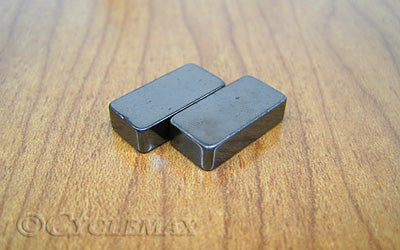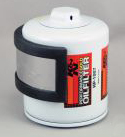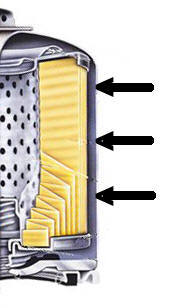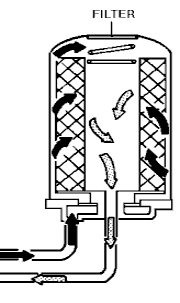Oil Filter Magnets - Qty 2
Couldn't load pickup availability
This is a pair of oil filter magnets. These ceramic magnets are made by G.W.R. Specialty Automotive Products and are designed to remove harmful metallic particles that are too small for the oil filter to catch. These magnets measure 3/4" X 3/8" X 3/16". These were designed to be small enough to fit into the Goldwing oil filters. You drop them both into any spin-on type oil filter where they hold themselves in place. Oil filters are designed to stop small particles down to the 20 micron size. To stop particles smaller than that, they would be too restrictive and not allow enough oil to pass through. 95% of the metallic particles that cause engine wear are smaller than that. These magnets pick up those particles. This process reduces engine wear dramatically. Then, when you change oil, just throw the filter and magnets away and install a new pair. You can re-use the magnets if you want to go through the trouble of removing and cleaning them at each oil change. But, for the price, most people just start with a fresh pair. They will fit all Goldwing GL1500's, GL1800's and F6B's. 80-1144S/2
Oil Filter Magnets
Save Fuel and Extend Engine Life 100% to 150%, for less than a penny per mile!
The easiest, fastest, least expensive way to clean the inside of an engine... period!
|
|---|
 |
Simply drop two SAE tested and certified "Ceramic Magnet" into a new oil filter and spin it on. Magnet locks to inner wall and can not be dislodged.
|
How about this for.... "Seeing is Believing"
|
|
|
When a GWR ceramic oil filter magnet is installed, you "instantly" start eliminating what the oil filter does not! Note that the average oil filter removes only 5% of the circulating particles of metal and harsh chemicals under 20 microns, leaving 95% to wear the internal parts.
Lower Risk of Oil Oxidation Too! Limited Flow Restriction
What have you got to lose??? |
For the techies in the group... here is what you are looking for! SOME IMPORTANT TEST RESULTS * SAE Technical Papers: 881827, 881825, 952555 & Additional Scientific Studies Lube oil contamination accounts for seventy to eighty percent of all failures and wear problems. The wear process promoted by oil contamination leads to diminished fuel efficiency, shorter useful oil service life, increased engine down time, reduced component life, loss of engine performance, and an overall increase in operating costs. Contaminant particles responsible for this damage are in the size range of the dynamic lubricant films separating moving engine component surfaces... 10 microns and smaller. Typically these particles pass through the oil filter and continue to build up in the oil system. By making simultaneous contact with opposing surfaces these harmful particles focus the load onto a small area, degrading the surface and perpetuating a chain-reaction-of-wear. There are three categories of oil contaminates active in the engine wear process: 1. Solid particles, including wear debris and soot, which damage mechanical components and catalyze lubricant breakdown; The predominant harmful impurities in engine oil are metallic particles and metal oxides. Typically there are well over 10,000 contaminant particles per milliliter of lube oil. Furthermore, approximately 90% of these particles are less than 10-microns in size. It's important to note that these particles generate about 3.5-times more wear than particles greater than 10-microns in size. This wear occurs because these particles are the size of, or slightly larger than the dynamic oil films separating opposing surfaces. Numerous studies have established a number of important points regarding the relationship between lube oil contamination and engine wear. 1. A reduced concentration of contaminant particles by a factor of 10-15 times; In summary, controlling particle contamination in the 1-10 micron size range retards the chain-reaction-of-wear, resulting in significant reductions in component wear and lubricant breakdown. The beneficial consequences include greater component life and reliability, increased oil change intervals, increased fuel efficiency, and a reduction in overall maintenance costs. Diesel Component Wear Test on DDA 6V-53T Engine Five critical component areas were tested: 1. Upper & Lower rod bearings. A. Diesel Engine Wear and Fuel Economy: A study of twenty-two 6-cylinder diesel engines performed by Fodor & Ling It was found reducing contamination from 0.016% by weight (standard oil filter) to 0.0025% by weight (extended filter / 10 micron control), reduced engine wear by a factor of 14. Most significantly, oil friction was reduced by 2.9% compared to operating with clean oil. This reduction was equated to an increase in fuel economy of about 4%. As a comparison, this significantly exceeds the 0.6 - 0.9% fuel economy gain experienced when converting from SAE 40 to multi grade lube oil. B. Survey of Diesel Engine Oil Contamination Levels Samples of 138 engines operating with standard paper filter were compared to 117 engines operating with upgraded 10-micron filters. Conclusions: 1. Diesel engine lube oil contamination causes wear of engine components. Wear of these components leads to loss of performance, increased maintenance and overhaul cost, lower fuel efficiency, and shorter lube oil service life. The ultimate benefits are greater diesel engine performance over extended life with lower operating cost. Independent Laboratory Test by Titan Labs Tests conducted by:
* IMPORTANT FACT
An 8 to 14 times reduction in engine wear. GWR Oil Filter Magnets can be added to virtually any oil filter and control particle contamination down to 0.5-microns. This is a 20-times improvement in particle control as compared to the SAE Technical Papers that indicate substantial wear reduction and fuel improvement by control down to only 10 microns. |















